Domestic hot water profile for that area was created by the USA and UK daily hot water profile. We used USA hot water consumption profile to be a guide of our hot water profile and using total value of the UK hot water usage to plot graph. The data of hot water requirement in the UK is the average value of hot water usage per person per day in different cases so it can be calculated to use in the profile.
The initial data of hot water consumption is use of the amount of hot water. Therefore it needs to be converted to power, that is used to heat water. The methodology using to calculate power of DHW
P = m *Cp*T; where m = mass flow (kg/s), Cp = 4.18 kJ/kg.C
T = 55 degree centigrade, P = power (Kwh)
We can find mass flow from the value of DHW consumption (m3/hr) and convert it to kg/s after that we can find power that used to heat water.
Input requirement
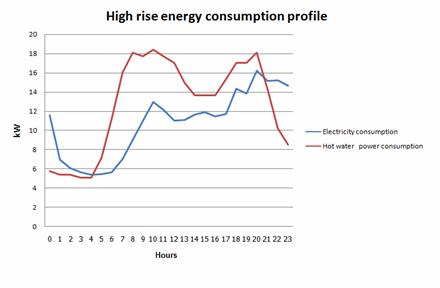
In case of high rise building, heat and power ration of this profile is 1.5:1.
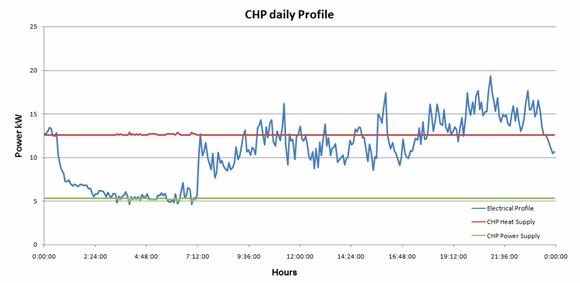
We created spreadsheet to do CHP analysis and this graph shows CHP daily profile of Baxi-Daches mini CHP, sizing with high rise and producing 5 kW of power and 12 kW of waste heat and we sized 1kWe of Whispergen micro CHP to tenement block as well. As this graph, we sized CHP power supply to cover based load of power requirement to avoid the problem with exporting exceed electricity to the grid in the night time. However, the main problem is how we crush the issue with constant heat supply and variable heat demand.
Output
How to calucate DHW tank size?
We used the maximum value of heat supply to calculate size of tank. In case of high rise the maximum value is around 20 kWh and time of adding hot water in tank is around 7 hours then it was computerized to 2.86 kW. After that we calculated by using that formular to get mass flow and then we can know the size of tank in unit of m3.
P = m *Cp*T; where m = mass flow (kg/s), Cp = 4.18 kJ/kg.C
T = 55 degree centigrade, P = power (kW)
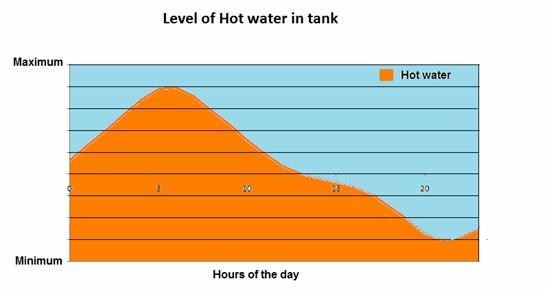
This graph shows level of hot water in tank in case of high rise, there is high level of hot water during night time due to low hot water requirement but during the day hot water requirement is high so level of hot water in the tank was decreased. However, in case of tenement block there is high level of unused hot water in tank due to efficiency of micro CHP so the size of tank will bigger than high rise case study. We can know size of tank using in 2 case studies.
We sized one whispergen micro-CHP for tenement block and Baxi daches mini-CHPs for high rise.
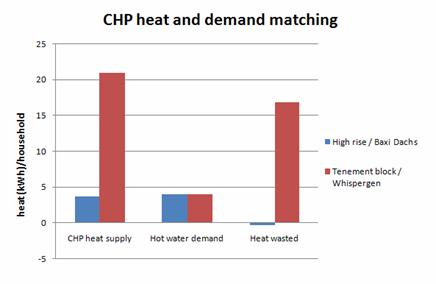
As a result, this graph shows case study comparison of high rise and tenement block and it was presented that high rise has small deficit of hot water requirement but it’s easily met by immersion heater in hot water tank. That means more efficiency CHP can match hot water load better. However, it still has heat wasted in each household of tenement block so it can be reduced by using “hot filled white goods option” such as washing machine and dish washer.
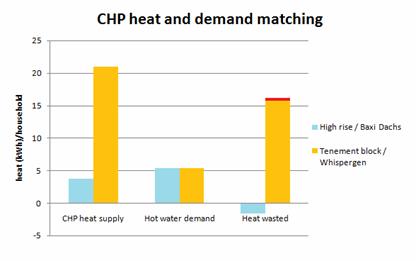
Thus this graph represents case study comparison when using 50% of hot filled white goods option. As u can see, heat wasted was reduced in case of tenement block after adding hot filled white goods option and a bit of red column is level of previous heat wasted and in case of high rise deficit heat requirement still increased.
It can be concluded that CHP is suitable with hot water requirement but it is recommended that CHP should have a minimum efficiency of 25 % is used to match with hot water system.
© University of Strathclyde 2009
![]()
